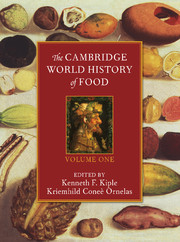Book contents
- Frontmatter
- Introduction
- Part I Determining What Our Ancestors Ate
- Part II Staple Foods: Domesticated Plants and Animals
- II.A Grains
- II.B Roots, Tubers, and Other Starchy Staples
- II.B.1 Bananas and Plantains
- II.B.2 Manioc
- II.B.3 Potatoes (White)
- II.B.4 Sago
- II.B.5 Sweet Potatoes and Yams
- II.B.6 Taro
- II.C Important Vegetable Supplements
- II.D Staple Nuts
- II.E Animal, Marine, and Vegetable Oils
- II.F Trading in Tastes
- II.G Important Foods from Animal Sources
- Part III Dietary Liquids
- Part IV The Nutrients – Deficiencies, Surfeits, and Food-Related Disorders
- References
II.B.1 - Bananas and Plantains
from II.B - Roots, Tubers, and Other Starchy Staples
Published online by Cambridge University Press: 28 March 2008
- Frontmatter
- Introduction
- Part I Determining What Our Ancestors Ate
- Part II Staple Foods: Domesticated Plants and Animals
- II.A Grains
- II.B Roots, Tubers, and Other Starchy Staples
- II.B.1 Bananas and Plantains
- II.B.2 Manioc
- II.B.3 Potatoes (White)
- II.B.4 Sago
- II.B.5 Sweet Potatoes and Yams
- II.B.6 Taro
- II.C Important Vegetable Supplements
- II.D Staple Nuts
- II.E Animal, Marine, and Vegetable Oils
- II.F Trading in Tastes
- II.G Important Foods from Animal Sources
- Part III Dietary Liquids
- Part IV The Nutrients – Deficiencies, Surfeits, and Food-Related Disorders
- References
Summary
Bananas represent one of the most important fruit crops, second only to grapes in the volume of world production (Purseglove 1988). J. F. Morton (1987) indicates that bananas are the fourth largest fruit crop after grapes, citrus fruits, and apples. Bananas and plantains are starchy berries produced by hybrids and/or sports of Musa acuminata Colla and Musa balbisiana. Rare genome contributions from another species may have occurred but are not yet well documented (Simmonds 1986). Additionally, fe'i bananas are obtained from Musa troglodytarum. Bananas may be differentiated from plantains on the basis of moisture content, with bananas generally averaging 83 percent moisture and plantains 65 percent (but intermediate examples may also be found) (Lessard 1992). Bananas may be eaten raw or cooked. Plantains are usually eaten cooked. Commonly, bananas which are eaten raw are referred to as dessert bananas. Throughout this essay, the term “bananas” is used to refer to both bananas and plantains.
Bananas, being primarily carbohydrates (22.2 to 31.2 percent), are low in fats, cholesterol, and sodium. Potassium levels are high (400 milligrams to 100 grams of pulp). Bananas are also good sources of ascorbic acid, 100 grams providing 13.3 to 26.7 percent of the U.S. RDA (Stover and Simmonds 1987). During ripening, the starch component is gradually converted to simple sugars (fructose, glucose, and sucrose), while the moisture content of the pulp increases. The time of conversion to simple sugars can also be used to differentiate plantains/cooking bananas (later conversion) from bananas that are eaten raw (earlier conversion).
Banana Plants
Bananas are monocarpic (fruiting once, then dying), perennial, giant herbs that usually are propagated via lateral shoots (suckers). Leaves are produced by a single apical meristem, which typically forms only a low short stem or pseudobulb.The leaves are tightly rolled around each other, producing a pseudostem with a heart of young, emerging, rolled leaves ending with the terminal production of a huge inflorescence (usually sterile) and, finally, the starchy fruits: bananas or plantains. 175
- Type
- Chapter
- Information
- The Cambridge World History of Food , pp. 175 - 181Publisher: Cambridge University PressPrint publication year: 2000
References
- 1
- Cited by

